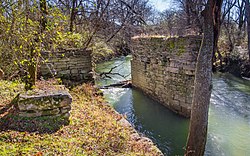| Revision as of 21:27, 20 January 2021 editWingerham52 (talk | contribs)Extended confirmed users1,291 editsNo edit summary← Previous edit | Latest revision as of 04:24, 19 August 2024 edit undoThis has to be edited (talk | contribs)467 editsNo edit summaryTag: Visual edit | ||
| (2 intermediate revisions by 2 users not shown) | |||
| Line 18: | Line 18: | ||
| }} | }} | ||
| '''Boyd Mill Ruins''' is a property in ] that was listed on the ] in 1988. | '''Boyd Mill Ruins''' is a property in ] that was listed on the ] in 1988. The mill was originally built in the early 19th century and was powered by the ]. It played a crucial role in the local economy, producing flour and cornmeal for area farmers for over 50 years. At its peak, it was one of about a dozen water-powered mills operating in Williamson County during the 19th century. | ||
| The mill |
The mill ceased operation around 1900 and subsequently fell into disrepair. Despite this, the stone foundations and turbine pit of the Boyd Mill remain more intact than those of any other former mill in the county, making it a valuable example of the milling industry's importance in 19th-century commerce.<ref name="mraWilliamson"/> | ||
| The W.A. Boyd farm was one of the larger farms |
The mill was part of the W.A. Boyd farm, which was one of the larger farms or plantations in Williamson County before and after the ]. Unlike many other farms that were reduced in size after the war, the Boyd farm remained substantial, encompassing 528 acres, including the Boyd Mill.<ref name="mraWilliamson">{{cite web|url={{NRHP url|id=64500624}} |title=Historic Resources of Williamson County (Partial Inventory of Historic and Architectural Properties), National Register of Historic Places Inventory Nomination |author=Thomason Associates and Tennessee Historical Commission | ||
| |date=February 1988 |publisher=]|page=28}}</ref> | |date=February 1988 |publisher=]|page=28}}</ref> | ||
| Line 40: | Line 40: | ||
| ] | ] | ||
| ] | ] | ||
| ] | ] | ||
| ] | |||
| ] | ] | ||
Latest revision as of 04:24, 19 August 2024
United States historic place| Boyd Mill Ruins | |
| U.S. National Register of Historic Places | |
 Boyd Mill Ruins Boyd Mill Ruins | |
  | |
| Location | E bank of the West Harpeth River, 1/10 mi. S of Boxley Valley Rd. and Boyd Mill Pike, Franklin, Tennessee |
|---|---|
| Coordinates | 35°55′15″N 86°58′1″W / 35.92083°N 86.96694°W / 35.92083; -86.96694 |
| Area | less than 1 acre (0.40 ha) |
| Built | early 19th century |
| MPS | Williamson County MRA |
| NRHP reference No. | 88000285 |
| Significant dates | |
| NRIS dates of significance | c.1840, c.1900 |
| Added to NRHP | April 13, 1988 |
Boyd Mill Ruins is a property in Franklin, Tennessee that was listed on the National Register of Historic Places in 1988. The mill was originally built in the early 19th century and was powered by the West Harpeth River. It played a crucial role in the local economy, producing flour and cornmeal for area farmers for over 50 years. At its peak, it was one of about a dozen water-powered mills operating in Williamson County during the 19th century.
The mill ceased operation around 1900 and subsequently fell into disrepair. Despite this, the stone foundations and turbine pit of the Boyd Mill remain more intact than those of any other former mill in the county, making it a valuable example of the milling industry's importance in 19th-century commerce.
The mill was part of the W.A. Boyd farm, which was one of the larger farms or plantations in Williamson County before and after the American Civil War. Unlike many other farms that were reduced in size after the war, the Boyd farm remained substantial, encompassing 528 acres, including the Boyd Mill.
The 157 acre Boyd-Wilson Farm, a century farm that is now also NRHP-listed, includes the Boyd Mill Ruins.
See also
References
- "National Register Information System". National Register of Historic Places. National Park Service. March 13, 2009.
- ^ Thomason Associates and Tennessee Historical Commission (February 1988). "Historic Resources of Williamson County (Partial Inventory of Historic and Architectural Properties), National Register of Historic Places Inventory Nomination". National Park Service. p. 28.
External links
| U.S. National Register of Historic Places | |
|---|---|
| Topics | |
| Lists by state |
|
| Lists by insular areas | |
| Lists by associated state | |
| Other areas | |
| Related | |
This article about a property in Williamson County, Tennessee on the National Register of Historic Places is a stub. You can help Misplaced Pages by expanding it. |
- Grinding mills on the National Register of Historic Places in Tennessee
- Buildings and structures in Williamson County, Tennessee
- Ruins on the National Register of Historic Places
- National Register of Historic Places in Williamson County, Tennessee
- Williamson County, Tennessee Registered Historic Place stubs